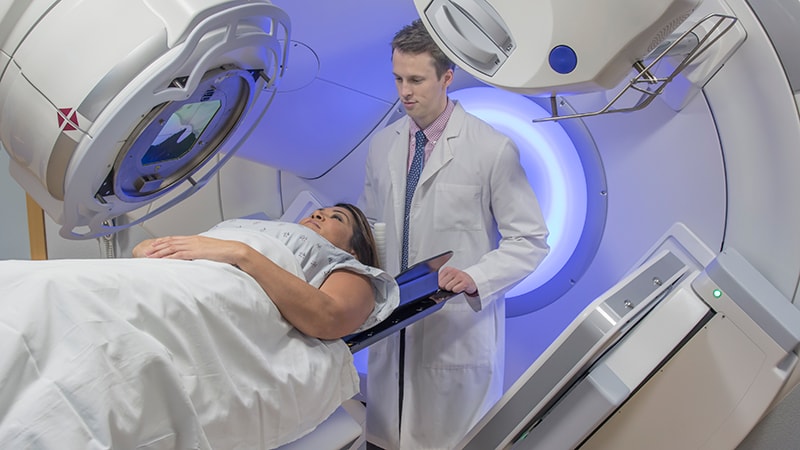Effectiveness of Personalized Radiation Therapy in Lung Cancer Treatment
Core Concepts
Individualized stereotactic ablative radiotherapy (SABR) based on lung tumor volume, location, and histology shows high local control and low toxic effects.
Abstract
TOPLINE:
Individualized SABR based on lung tumor characteristics led to high local control and low toxic effects.
METHODOLOGY:
Phase 2 study on 217 patients with 285 lung tumors.
SABR dose customized by tumor size, location, and history.
TAKEAWAY:
25 Gy in 1 fraction was the most common dose.
Local recurrence at 1 year was 97% in group 1, 94% in group 2, and 96% in group 3.
Low toxic effects at 5%.
IN PRACTICE:
Individualized SABR for lung tumors can provide excellent tumor control.
SOURCE:
Study led by Michael Gensheimer, MD, from Stanford University, published in JAMA Oncology.
LIMITATIONS:
Lack of a uniform dosing control arm.
DISCLOSURES:
Study supported by Stanford University and Hokkaido University.
Time for Personalized Radiation Therapy in Lung Cancer?
Stats
Doses ranged from 25 Gy in 1 fraction to 60 Gy in 8 fractions.
Freedom from local recurrence at 1 year: 97% in group 1, 94% in group 2, 96% in group 3.
Proportion of patients with grade 3 to 5 toxic effects was 5%.
Quotes
"Individualized SABR for lung tumors can help minimize treatment dose and may be associated with excellent tumor control." - Study authors
Key Insights Distilled From
by Megan Brooks at www.medscape.com 09-21-2023
https://www.medscape.com/viewarticle/996689
Deeper Inquiries
How can individualized SABR be implemented on a larger scale?
Individualized SABR can be implemented on a larger scale by establishing standardized protocols and guidelines based on tumor volume, location, and histology. This would involve creating algorithms or decision support tools that can assist clinicians in determining the optimal SABR dose and fractionation for each patient. Additionally, training programs can be developed to educate healthcare providers on the principles and techniques of personalized radiation therapy. Collaborations between academic centers, research institutions, and healthcare facilities can also facilitate the dissemination of knowledge and best practices in individualized SABR.
What are the potential drawbacks of personalized radiation therapy in lung cancer treatment?
Despite its benefits, personalized radiation therapy in lung cancer treatment may have some potential drawbacks. One limitation is the lack of uniform dosing control arms in studies, which can make it challenging to compare the effectiveness of individualized SABR with standard treatment approaches. Additionally, the primary outcome of 1-year local recurrence may not capture all relevant data, as some local recurrences in SABR-treated NSCLC can occur later. There may also be logistical challenges in implementing personalized radiation therapy on a larger scale, such as resource constraints, technological limitations, and variability in expertise among healthcare providers.
How can advancements in personalized medicine impact other cancer treatments?
Advancements in personalized medicine, such as individualized SABR in lung cancer treatment, can have a significant impact on other cancer treatments. By tailoring therapies to the specific characteristics of each patient's tumor, personalized medicine can improve treatment outcomes, reduce toxic effects, and enhance overall survival rates. This approach can also lead to more precise and targeted therapies, minimizing unnecessary treatments and optimizing the use of resources. Furthermore, advancements in personalized medicine can pave the way for the development of innovative treatment strategies, including combination therapies, immunotherapies, and gene-targeted therapies, that can be customized to each patient's unique genetic profile and disease characteristics.
0
